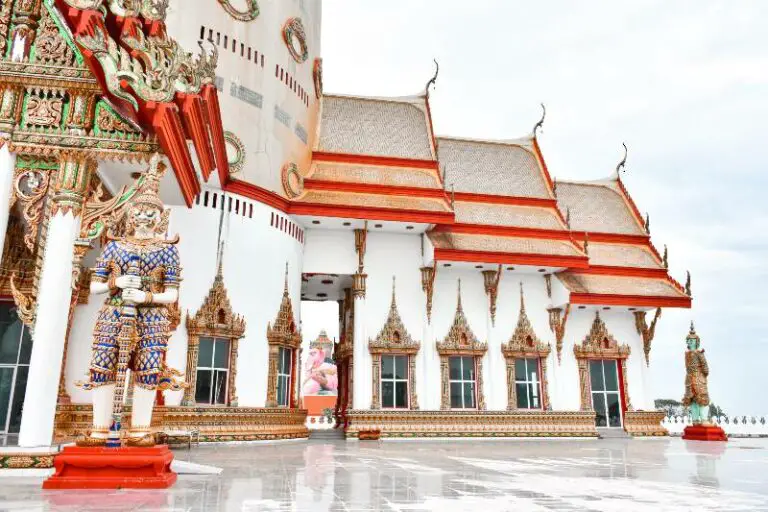Thailand’s Rainy Season: A Unique Travel Experience
If you’re planning a trip to Thailand, chances are you’ve heard stories of torrential rains, dense jungles, and all sorts of wild adventures. But the truth is that traveling during the rainy season in Thailand can be one of the most rewarding experiences imaginable! From its stunning mountains covered in lush greenery to laid-back beach towns and bustling cities – there’s something for everyone no matter what time of year you choose to visit.
In this blog post, we’ll explore why traveling in Thailand during its wet season could actually make your experience richer than if visited between November and March (the dry season), as well as provide tips on how to maximize your fun while staying safe along the way. So whether it’s an off-the-beaten-path temple or a majestic waterfall – let’s explore why now is actually an ideal time for those looking for adventure when visiting this incredible corner of Southeast Asia!
Thailand experiences its rainy weather or ‘monsoon’ season from July to October. During the initial months, the rainfall is intense but sporadic, lasting only for a few hours. However, as the season progresses, the rain becomes more consistent. For optimal weather conditions, the ideal time to visit is during the hot season, which spans from March to June.
Key Takeaways
- The rainy season in Thailand, often overlooked by tourists, offers a unique travel experience with fewer crowds, lush landscapes, and unique festivals.
- While weather conditions during this season can be unpredictable, there are ample indoor and covered activities to engage in, from museums to cooking classes and indoor sports.
- Visiting Thailand during the rainy season requires some extra preparation, including packing suitable clothing and taking certain health and safety measures, but the rewards are rich in cultural immersion and unique experiences.

The Rainy Season: What to Expect
Average weather conditions
The rainy season in Thailand, often referred to as the “green season”, generally runs from May through October, though its onset and duration can vary depending on the region. During this period, the country experiences heavy but often short-lived downpours, typically occurring in the late afternoon or evening. Despite the name “rainy season”, it does not rain all day every day. In fact, some days might not see any rainfall at all. The average temperature can range from 25°C to 33°C (77°F to 91°F), maintaining a warm, tropical climate throughout the season. High humidity levels, often reaching up to 90%, can make the air feel denser and warmer.
The rainfall can significantly affect coastal conditions. For example, in the Andaman Sea (west coast), heavy monsoon winds can cause rough seas and reduced visibility, making some water-based activities less accessible or safe. The Gulf of Thailand (east coast), however, may experience less severe weather due to its geographical positioning.
How locals adapt to the season
Thais are well accustomed to the rhythm of the rainy season and have adapted their lifestyles accordingly. The locals may carry compact, easily portable umbrellas or rain ponchos, which are often sold at every corner and can be bought inexpensively in case of sudden showers. Street vendors often adjust their opening hours to the afternoon and evening to dodge the most intense bouts of rain and serve the community returning home from work.
The rainy season is a crucial period for agriculture, and the lush greenery it brings is a sight to behold. Farmers take advantage of the abundant rainfall to plant rice, the country’s primary crop, transforming the landscapes into verdant, water-filled terraces.
Moreover, there are several festivals associated with the rainy season in Thailand. For instance, the Loy Krathong festival, which celebrates the goddess of water, sees locals releasing beautifully decorated baskets into rivers and lakes – a tribute to the water that sustains them.
Precautions for visitors during the rainy season
Visitors to Thailand during the rainy season should be prepared for potential changes in weather and occasional disruptions in their plans. The first rule of thumb is to carry a compact umbrella or a lightweight raincoat, as tropical downpours can be sudden and intense.
While many tourist attractions remain open, the heavy rains can lead to occasional closures or may render certain outdoor activities, like hiking, less enjoyable or safe. Therefore, visitors should always check the weather forecasts and follow local advice on safety.
Water-based activities, particularly on the Andaman Sea, should be approached with caution. High waves and strong currents can be dangerous, so always respect red flag warnings at the beaches and avoid boat trips if the weather is unstable.
In terms of health, the rainy season can see a rise in mosquitoes, which in some cases can carry diseases like dengue fever. It’s advisable to apply mosquito repellent regularly and consider wearing clothing that covers the skin, particularly in the evenings when mosquitoes are more active.
Travel insurance is also recommended to cover any unexpected disruptions or health issues that might arise. Ultimately, with the right precautions, the rainy season can be a beautiful time to visit Thailand, offering lush landscapes, fewer tourists, and a unique cultural perspective.
Attractions During the Rainy Season
Waterfalls and natural sites
Thailand’s tropical climate means the country is rich in natural beauty, and the rainy season is the prime time to experience this. Many of Thailand’s waterfalls, such as Erawan Falls in Kanchanaburi, come alive during the rainy season, cascading with full force and surrounded by lush vegetation. Visiting these sites during or immediately after a rain shower can be a truly awe-inspiring experience, as long as visitors heed safety warnings about slippery paths and strong currents.
Khao Sok National Park, one of Thailand’s rainforest gems, is another stunning destination during the rainy season. The rainfall intensifies the forest’s verdant green color, and the cool temperatures make trekking more comfortable. Plus, you might even spot wildlife that tends to be more active during this time.
Indoor attractions: museums, temples, shopping malls
For those rainy days when you prefer to stay indoors, Thailand has a rich offering of museums and temples that provide cultural insights. In Bangkok, the Grand Palace, with its magnificent Wat Phra Kaew (Temple of the Emerald Buddha), offers sheltered sections to explore. The Bangkok National Museum and the Museum of Siam are also excellent places to delve into Thai history and culture.
Thailand’s shopping malls are an attraction unto themselves, and they come as a great relief during heavy downpours. In Bangkok, malls such as the Siam Paragon, CentralWorld, and MBK Center not only offer a wide range of shopping options, but also house cinemas, restaurants, and even aquariums and art galleries.
Rainy season festivals
The rainy season coincides with a number of exciting cultural festivals in Thailand. As mentioned earlier, the Loy Krathong festival is a significant event that falls in November, at the end of the rainy season. This festival sees locals and tourists releasing decorated baskets or lanterns on water bodies to pay respects to the water goddess.
Another notable festival is the Candle Festival in Ubon Ratchathani, usually held in July to mark the start of the Buddhist Lent period, known as “Khao Phansa”. The festival features a grand procession of elaborately carved beeswax candles and is one of the most visually stunning events in Thailand. These festivals provide a wonderful opportunity for visitors to immerse themselves in Thai culture and traditions, adding a unique touch to their rainy season visit.
Activities Suited for the Rainy Season
Thai cooking classes
Cooking classes are a perfect indoor activity during the rainy season. Not only do you stay dry, but you also get to learn about Thai cuisine’s rich and varied flavors. Classes often start with a visit to a local market, where you’ll experience the hustle and bustle of everyday life in Thailand and learn about the different ingredients used in Thai dishes. Back in the kitchen, you’ll be guided by an expert chef who will teach you how to create traditional Thai dishes, from zesty green curry to sweet mango sticky rice.
This not only allows you to explore Thai culture through its cuisine but also equips you with skills that you can take back home. Cooking schools like the Bangkok-based Blue Elephant or Chiang Mai’s Thai Farm Cooking School are popular choices, offering a range of classes for different skill levels.
Check out this article that I wrote about Beyond Pad Thai: Exploring Unconventional Thai Dishes You Must Try. I can tell you firsthand that it was a fun and delicious adventure! From stir-fried morning glory to the spicy soups of Isan, it was an incredible journey through some of Thailand’s lesser-known regional dishes.
Spa and wellness activities
The rainy season is an excellent time to explore Thailand’s renowned wellness industry. Thai massage, a traditional practice that dates back centuries, can be a fantastic way to relax and while away a rainy afternoon. In addition to Thai massage, many spas offer treatments like hot stone therapy, herbal compresses, and various forms of aromatherapy that can provide rejuvenating experiences.
For a deeper immersion into wellness, consider visiting a yoga or meditation retreat. Thailand has many retreats, particularly in the northern region around Chiang Mai and the southern islands like Koh Samui, that provide serene environments perfect for self-reflection and relaxation.
Indoor sports
If you’re looking for more active indoor pursuits, Thailand has a range of options. From rock climbing at indoor facilities such as the Rock Domain Climbing Gym in Bangkok, to bowling alleys found in many of the larger shopping malls, you can easily find ways to keep moving during the rainy season.
In addition, Muay Thai, the country’s national sport, is a thrilling indoor activity. Many gyms offer classes for beginners, providing an opportunity to get a great workout and learn about this significant aspect of Thai culture. There’s a range of options to choose from, including the prestigious Fairtex Training Center in Pattaya or the more tourist-friendly Tiger Muay Thai in Phuket.
Remember, even though the rainy season in Thailand may seem like a deterrent, it can be a time to engage in unique and immersive indoor experiences that you might overlook during sunnier periods. As always, pack your days with activities that interest you and embrace the opportunities that the season presents.
Food and Drinks to Try During the Rainy Season
Seasonal Thai dishes
Thai cuisine is known for its diverse flavors and unique blend of spices, and the rainy season offers its own set of seasonal delicacies to explore. During these cooler months, warm and hearty dishes are a go-to for locals.
One such dish is ‘Gaeng Som’, a spicy and sour soup that is a rainy season favorite. Made with tamarind paste for its sourness, chilli for its heat, and a variety of local vegetables and proteins, this comforting soup can warm you up in the damp weather.
Another traditional Thai dish to enjoy during the rainy season is ‘Khao Soi’. Primarily found in Northern Thailand, Khao Soi is a rich, coconut milk-based noodle soup, often served with chicken or beef, and topped with crispy egg noodles, pickled mustard greens, and a slice of lime. This warm, comforting dish is perfect for cooler, rainy days.
Hot drinks to enjoy in the cooler weather
Thailand offers a variety of warm beverages to keep you cozy during the cooler rainy season. Thai tea, or ‘Cha Yen’, is a local favorite. While it’s often served iced, you can also enjoy it hot. Made from strong black tea, spices, sugar, and condensed milk, it’s a sweet treat that can be found throughout the country.
If you’re a coffee lover, ‘Oliang’ is a must-try. This is a unique Thai iced coffee drink, but like Thai tea, can also be enjoyed hot. Oliang is a strong, dark-roast coffee blend, often mixed with corn and soybeans, and is typically sweetened with condensed milk.
Another warm drink to enjoy is Thai ginger tea, or ‘Nam King’. This warming, spicy beverage is made by boiling ginger with water and adding a dash of sugar for sweetness. Not only does it warm you up, but ginger tea is also known for its health benefits, including aiding digestion and reducing inflammation.
Tips for Traveling in Thailand During the Rainy Season
- Flexible itinerary: Keep your plans flexible as unexpected rain could mean rescheduling outdoor activities. Incorporate a mix of indoor and outdoor activities in your itinerary so you have a backup plan in case of heavy rains.
- Appropriate Clothing: Pack lightweight, quick-drying clothing. Waterproof jackets or ponchos and umbrellas are a must. Consider packing waterproof bags or cases to protect electronics and important documents.
- Footwear: Waterproof footwear or sandals that can handle getting wet are advisable, especially when visiting natural sites or walking around cities during a downpour.
- Stay Informed: Always check weather updates and heed local advice, especially for activities such as boat rides, hiking, or visits to waterfalls where conditions can be significantly impacted by the weather.
- Health precautions: Due to the increase of mosquitoes during this season, bring along mosquito repellent and consider wearing longer sleeves and pants in the early mornings and evenings when mosquitoes are most active.
With the right mindset and preparation, traveling during the rainy season in Thailand can be a wonderful experience, filled with delicious seasonal foods, comforting hot drinks, and an array of cultural and indoor activities to keep you entertained.
Tips for Traveling in Thailand During the Rainy Season
What to pack
Traveling during the rainy season in Thailand requires some additional items in your packing list.
- Waterproof Gear: Essential items include a lightweight, waterproof jacket or a disposable rain poncho and a sturdy umbrella. Having these on hand can help you deal with sudden downpours.
- Clothing: Opt for quick-drying, breathable fabrics. It’s also worth packing a warmer layer for the cooler evenings. A waterproof cover for your backpack or suitcase can be useful as well.
- Footwear: A pair of waterproof shoes or sandals that dry quickly is ideal for navigating wet streets or muddy trails.
- Electronics Protection: Waterproof cases or bags for electronics and important documents are highly recommended, as unexpected rain showers can catch you off guard.
- Insect Repellent: Rainy season also means mosquito season, so pack a good insect repellent. Mosquitoes are more active at dawn and dusk, so make sure to apply the repellent if you’re out during these times.
Getting around
The rainy season can affect the mode of transportation in Thailand.
- Local Transport: Within cities, local transport options like tuk-tuks and motorbike taxis are still available, but for a drier ride, consider metered taxis or rideshares.
- Ferries: If you’re planning to visit Thailand’s islands, note that some ferry services might be reduced, especially on the Andaman Sea side, due to rough sea conditions. Always check the schedules and the weather forecast in advance.
- Flights and Trains: Domestic flights and trains generally operate as usual, although there may be occasional delays due to weather conditions. Keep a close eye on your schedules and allow for some flexibility in your travel plans.
Staying safe and healthy
- Food and Water Safety: Stick to bottled water and ensure your food is properly cooked to avoid any foodborne illnesses.
- Insect Bites: As mentioned earlier, mosquitoes can be more prevalent during the rainy season. Ensure you’re well protected with insect repellent and suitable clothing, especially during early morning and late evening.
- Physical Safety: Pathways, especially in natural sites, can be slippery when wet. Take extra care when walking around after rain. Also, be aware that heavy rains can cause flooding or landslides in some areas. Always heed local advice and warnings about weather conditions and safety.
- Health Insurance: Ensure you have travel insurance that covers any medical emergencies. Hospitals in Thailand offer excellent care, but costs can be high for foreigners.
- Respect Red Flags: When at the beach, never ignore red flags. These are indications of strong currents and waves, and swimming is highly discouraged when these flags are up.
Traveling to Thailand during the rainy season can be a unique and rewarding experience with proper planning and precautions. Embrace the season and enjoy the unique beauty and tranquillity it brings.

Thailand during the rainy season FAQs
Best Indoor Attractions in Thailand During the Rainy Season
- Bangkok National Museum: Located in the heart of Bangkok, this museum houses an extensive collection of Thai art, history, and cultural artifacts and is an excellent way to spend a rainy day exploring Thailand’s rich heritage.
- Art in Paradise: Found in both Chiang Mai and Pattaya, these interactive 3D art galleries offer hours of entertainment and countless photo opportunities for the whole family.
- Siam Ocean World: Located in Bangkok, this is one of the largest aquariums in Southeast Asia. It offers a dry, climate-controlled environment to view hundreds of different marine species.
- Cooking Classes: Numerous establishments, especially in tourist-heavy areas like Chiang Mai, Bangkok, and Phuket, offer Thai cooking classes. This is a great way to learn more about Thai cuisine and culture while staying dry.
- Shopping Malls: Thailand’s shopping malls are attractions in and of themselves, with everything from high-end fashion to local crafts, as well as food courts, movie theaters, bowling alleys, and even indoor amusement parks. Some of the most famous ones include Siam Paragon and CentralWorld in Bangkok.
What are some unique festivals that occur during Thailand’s rainy season?
One of the most exhilarating events is the Bun Bang Fai Rocket Festival, held in the northeastern region at the onset of the rainy season, typically between April and June depending on the specific location. This vibrant celebration is dedicated to launching handmade bamboo rockets towards the mighty deity, Phaya Thaen, as a plea for abundant rainfall during the rice-growing season.
Over time, this festival has evolved into a spirited competition, with participants vying to send their towering rockets soaring into the heavens. The accolade is bestowed upon the rocket that reaches the highest altitude, proclaiming it the triumphant champion of the skies.
What are the must-try foods in Thailand during the rainy season?
Thai-style Fried Chicken (Gai Tod) is one of the most popular street foods in Thailand. It is a delicious, spicy, and crispy fried chicken dish that can be enjoyed with sticky rice or served as a snack. Gai Tod can be cooked in a variety of ways, such as deep-fried in oil, grilled on an open flame, or cooked with sauces for added flavor.
What safety measures should I take when visiting Thailand during the rainy season?
When planning a trip to Thailand during the rainy season, it is essential to prepare for potential flooding. Make sure you research your destination and check local forecasts before leaving home so that you can plan ahead. Consider packing rain gear such as a waterproof jacket or umbrella in case of heavy downpours.
Conclusion
The rainy season of Thailand may be overlooked by travelers, but offers a unique and captivating experience all its own. With few crowds and lush landscapes, visitors can engage in activities like outdoor festivals and indoor cooking classes whilst taking in the beauty of the country. However, extra preparation is needed to ensure the enjoyment of this season – from packing appropriate clothes to taking necessary safety and health precautions.
Nonetheless, those who take the necessary steps will be rewarded with a deeply immersive cultural experience that cannot be found during dryer times of the year. If you’d like more information about living in Thailand or need help getting prepared for your visit, don’t hesitate to reach out! Be sure also to subscribe to our newsletter for more helpful tips on planning your getaway during the rainy season.






